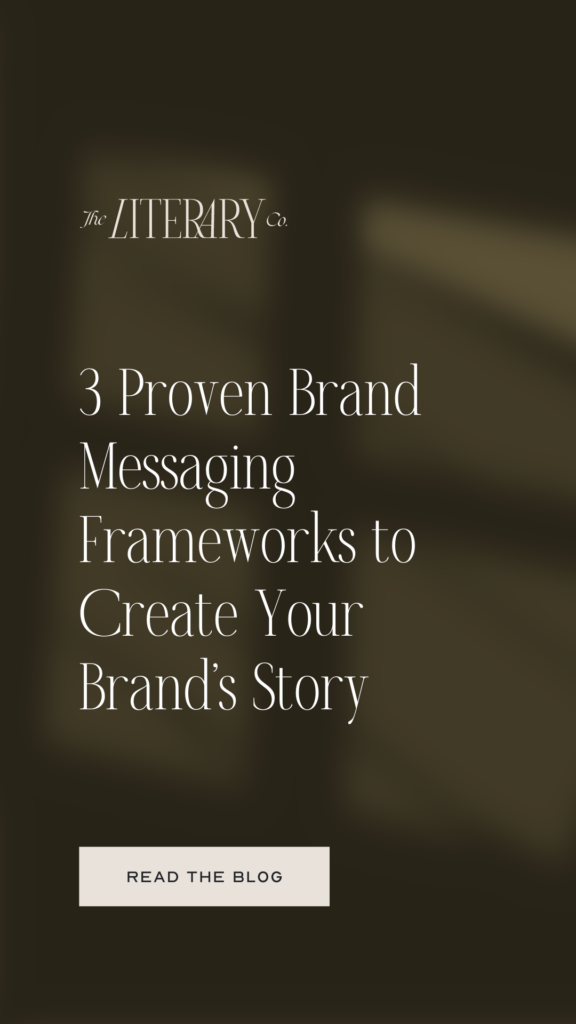When it comes to creating a brand message that really works, you may find yourself struggling in the weeds. Luckily, with so many amazing, established brand messaging frameworks, you don’t have to go it alone to create an unforgettable message.
In the brand messaging guides we create for clients, we have our own elements that we incorporate but also rely upon industry-standard frameworks that are proven to convert time and again.
Read on for our 3 favorite brand messaging frameworks, and discover how they can help you create a story you’re excited to share.

Brand Messaging Framework #1: Storybrand
Storybrand, could I? In Building a Storybrand, author Donald Miller shares a simple, straightforward approach to building a brand:
A character has a problem and meets a guide who gives them a plan and calls them to action to help them avoid failure and ends in success.
Basically, if we are to successfully communicate with our audience, we need to know who they are (and no, you can’t just say they shop at Anthropologie or buy Lululemon sweats). We need to know what their problem is from several different levels: the villain (or core frustration), their internal struggles, external thoughts about those struggles, and even the philosophical problem.
That’s right. Successful messaging depends not only on what keeps your client stuck and frustrated, but also what makes them feel empowered and core elements that even transcend your product/service itself.
Then they need to know that YOU are their guide, that you’ll be the one to mirror the transformation they want to see, give them urgency to solve that problem with your help, and then experience profound success because you brought them along a transformational journey.
There’s a reason that this framework is the gold standard in our industry: it works for literally everything. I generally use it to guide my clients in the website copywriting process, but it’s easily applicable to creating messaging around specific offers, and even bringing your findings into writing all the copy you’ll need in your brand (because, after all, the writing doesn’t stop after your website is done).
If you’re DIYing and not ready to hire a copywriter, this will give you a great foundation to work from. However, when you’re finally ready to invest, a copywriter can take your ideas and elevate them to a new level.
Often, our clients are people who have read the book, loved the core ideas, and tried implementing, but ultimately found that outsourcing their messaging was the best way for them to come home to what makes their brand unique and stand stronger than ever before.
Brand Messaging Framework #2: Golden Circles
In Start With Why, Simon Sinek explains his methodology of the Golden Circles. Essentially, it’s a 3-part method, starting with WHAT you do, going more in-depth to HOW you do what you do, and then, fundamentally answering the question of WHY you do what you do.
Essentially, while messaging IS a story, a great brand is even better supported by the knowledge of WHY. The philosophical problem in the Storybrand framework also addresses this quite nicely.
If you’re just starting out, it’s possible you don’t know WHY yet. And that’s okay. A what may be enough to get started. But the more you grow your business, work with clients, and spend time serving your audience, you will get into the depth of that why. It will inform what you do and make your brand story so much better.
Knowing why not only gives your audience urgency. It also shows them the importance of taking action with you.
Brand Messaging Framework #3: Epiphany Bridge
Created by Russell Brunson, the Epiphany Bridge is a storytelling method built to give your audience an epiphany that, most frequently, mirrors your own. When you’re telling the story of who you are, why you got started, and how you are uniquely equipped to help, you want to speak from your own experience to trigger feelings of empathy and connection in the people you want to reach.
The Epiphany Bridge is made up of the backstory, desires, external struggle, and internal struggle. Sounds pretty similar to the Storybrand framework, right? But here’s where we change the script: with the wall, the problem you encountered that kicked off your current journey. For example, did you lose your job and start a business? Struggle to find vegan baby food and set out to create your own? Built a strategy-first process because all the other studios were just giving their clients pretty color palettes?
Then we follow that up with the epiphany, the plan, the conflict, the achievement, and the transformation.This printable worksheet breaks it down into actionable steps that you can then use to frame your brand’s origin story.
Bonus: Pixar Story Framework
Originally designed to show how Pixar tells stories, Emma Coates created this framework for a presentation. Now, it’s a well-known way to share compelling stories, whether you’re a brand storyteller or fiction writer.
The framework looks like this:
Once upon a time there was ____________ [context/background/set the scene]
Every day ____________ [problem/issues that arose]
Then one day ____________ [the wall/obstacle]
Because of that, ____________ [resulting situation/conflict]
And because of that, ____________ [action taken]
Until finally, ____________ [resolution/transformation]
If it’s hard to take this framework and imagine what this could look like for your business, here’s an example of how I use it in mine:
Once upon a time, there was a creative business owner who loved to sell her services online. Every day, she loved her work but struggled to communicate the power of her services to her potential clients. Then one day she realized that she was ready to reach the next level in her business, to book further in advance and reach high-ticket clients. Because of that, she hired a copywriter to help her understand, distill, and express her brand story beautifully and in a way that attracted her clients. And because of that, she updated her website and started speaking more confidently to her clients. Until finally, she connected with her dream clients and experienced more success than ever before.
Doesn’t this sound awesome? When you know how you can help, that is a serious game-changer.
Check out this Forbes article for other examples of how this can work for you! For even more ideas Emma Linh has a 4-part framework to get you thinking about the bigger picture of your brand story.
Are you ready to build a brand fueled by storytelling? Get in touch and let us help you build your brand message.
issued on
April 7, 2022
Coming Soon
Accessible copywriting resources
for business owners
templates, workshops, & guides
The Copy Society is getting an update! In the fall, we're launching a digital product shop with website copywriting templates and ways to get support as you DIY your copy. Add your email below to be made aware when we launch. You'll also receive our twice-monthly newsletter, To The Letter.
